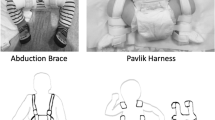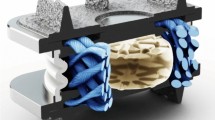Abstract
Purpose
Late-onset Perthes’ disease is diagnosed after 9 years of age. Conservative treatment and conventional surgical techniques have limited ability to reduce the pressure in the joint or change the shape of the femoral head. We used a combination of soft tissue release and joint distraction with a hinged mono-lateral external fixator for these patients. Ten of our patients reached skeletal maturity and were evaluated.
Methods
Clinical assessment included: Harris hip score, hip range-of-motion (ROM), limb length discrepancy, and the Oxford hip questionnaire for pain and function. Radiographic assessment included: Sharp transverse acetabular inclination, the uncoverage percentage, the epiphyseal index before surgery (modified Eyre–Brook), at frame removal, and, at last follow-up, the epiphyseal quotient (of Sjovall) and the Stulberg classification.
Results
Our study included eight boys and two girls (mean age at surgery 12.3 years, range 9.4–15.1, mean age at last follow-up 18.1 years, range 15.2–22.8). The mean follow-up was 5.7 years (range 4.3–7.8). The mean Harris hip score was 86.3/100 (range 48.5–96); one patient had <85 points. The hip ROM was slightly limited in most patients, and seven patients had limb shortening between 1–4 cm. The mean Oxford hip questionnaire score was 17.4/60 (range 12–31). The mean Sharp transverse acetabular inclination of the affected side was 42° (range 36–54) compared to 39° for the unaffected side (P = 0.045). The mean uncoverage percentage was 37% (range 27–47) compared to 20% for the unaffected side (P = 0.017). The mean epiphyseal index was 0.71 (range 0.31–0.92) before surgery, 0.79 (range 0.50–0.93) at frame removal (P = 0.012), and 0.72 (range 0.51–0.89) at last follow-up (P = 0.646). The epiphyseal quotient for the eight unilateral cases was 0.72 (range 0.49–0.91), and the Stulberg classification was type III for three cases and type IV for seven.
Conclusion
Patient satisfaction for function and pain following the combined procedure was good. Radiographic parameters did not change significantly. This should be regarded as a salvage procedure.


Similar content being viewed by others
References
Joseph B, Mulpuri K, Varghese G (2001) Perthes’ disease in the adolescent. J Bone Joint Surg Br 83-B:715–720
Caterrall A (1981) Legg–Calve–Perthes syndrome. Clin Orthop Relat Res 58:41–52
Skaggs DL, Tolo VT (1996) Legg–Calve–Perthes disease. J Am Acad Orthop Surg 4:9–16
Weinstein SL (1997) Natural history and treatment outcomes of childhood hip disorders. Clin Orthop Relat Res 344:227–242
Weinstein SL (2000) Long-term follow-up of pediatric orthopaedic conditions (Bristol-Myers Squibb/Zimmer Award for distinguished achievement in orthopaedic research). J Bone Joint Surg Am 82:980–990
Yrjonen T (1999) Long-term prognosis of Legg–Calve–Perthes disease: a meta-analysis. J Pediatr Orthop B 8:169–172
Guille JT, Lipton GE, Szoke G, Bowen JR, Harcke HT, Glutting JJ (1998) Legg–Calve–Perthes disease in girls. A comparison of the result with those seen in boys. J Bone Joint Surg Am 80:1256–1263
Ismail AM, Macnicol MF (1998) Prognosis in Perthes’ disease. A comparison of radiological predictors. J Bone Joint Surg Br 80:310–314
Mazda K, Pennecot GF, Zeller R, Taussig G (1999) Perthes’ disease after the age of twelve years. Role of the remaining growth. J Bone Joint Surg Br 81:696–698
Guerardo E, Garces G (2001) Perthes’ disease. A study of constitutional aspects in adulthood. J Bone Joint Surg Br 83:569–571
Noonan KJ, Price CT, Kupiszewski SJ, Pyevich M (2001) Results of femoral varus osteotomy in children older than 9 years of age with Perthes disease. J Pediatr Orthop 21:198–204
Friedlander JK, Weiner DS (2000) Radiographic results of proximal femoral varus osteotomy in Legg–Calve–Perthes disease. J Pediatr Orthop 20:566–571
Bankes MJK, Catterall A, Hashemi-Nejad A (2000) Valgus extension osteotomy for hinge abduction’ in Perthes’ disease. J Bone Joint Surg Br 82-B:548–554
Dimitriou JK, Leonidou O, Pettas N (1997) Acetabulum augmentation for Legg–Calve–Perthes disease. 12 children (14 hips) followed for 4 years. Acta Orthop Scand 68(Suppl 275):103–105
Daly K, Bruce C, Catteral A (1999) Lateral shelf acetabuloplasty in Perthes’ disease. A review at the end of growth. J Bone Joint Surg Br 81-B:380–384
Kuwajima SS, Crawford AH, Ishida A, Roy DR, Filho JL, Milani C (2002) Comparison between Salter’s innominate osteotomy and augmented acetabuloplasty in the treatment of patients with severe Legg–Calve–Perthes disease. Analysis of 90 hips with special reference to roentgenographic sphericity and coverage of the femoral head. J Pediatr Orthop B 11:15–28
Kim HT, Wenger DR (1997) Surgical correction of “functional retroversion” and “functional coxa vara” in late Legg–Calve–Perthes disease and epiphyseal dysplasia: correction of deformity defined by new imaging modalities. J Pediatr Orthop 17:247–254
Koyama K, Higuchi F, Inoue A (1998) Modified Chiari osteotomy for arthrosis after Perthes’ disease. 14 hips followed for 2–12 years. Acta Orthop Scand 69:129–132
Kim YJ, Ganz R, Murphy SB, Buly RL, Millis MB (2006) Hip joint-preserving surgery: beyond the classic osteotomy. Instr Course Lect 55:145–158
Canadell J, Gonzales F, Barrios RH, Amillo S (1993) Arthrodiastasis for stiff hips in young patients. Int Orthop (SICOT) 17:254–258
Kocaoglu M, Kilicoglu OI, Goksan SB (1999) Ilizarov fixator for treatment of Legg–Calve–Perthes disease. J Pediatr Orthop B 8:276–281
Kucukkaya M, Kabukcuoglu Y, Ozturk I, Kuzgun U (2000) Avascular necrosis of the femoral head in childhood: the results of treatment with articulated distraction method. J Pediatr Orthop 20:722–728
Thacker M, Feldman D, Madan S, Straight J, Scher D (2005) Hinged distraction of the adolescent arthritic hip. J Pediatr Orthop 25:178–182
Segev E, Ezra E, Wientroub S, Yaniv M (2004) Treatment of severe late onset Perthes’ disease with soft tissue release and articulated hip distraction: early results. J Pediatr Orthop B 13:158–165
Harris WH (1969) Traumatic arthritis of the hip after dislocation and acetabular fractures: treatment by mold arthroplasty. An end-result study using a new method of result evaluation. J Bone Joint Surg Am 51:737–755
Kalairajah Y, Azurza K, Hulme C, Molloy S, Drabu KJ (2005) Health outcome measures in the evaluation of total hip arthroplasties—a comparison between the Harris hip score and the Oxford hip score. J Arthroplasty 20:1037–1041
Tonnis D (1986) General radiography of the hip joint. In: Congenital dysplasia and dislocation of the hip. Springer (English edition), Berlin pp 100–142
Stulberg SD, Cooperman DR, Wallenstein R (1981) The natural history of Legg–Calve–Perthes disease. J Bone Joint Surg Am 7:1095–1108
Neyt JN, Weinstein SL, Spratt KF, Dolan L, Morcuende J, Dietz FR, Guyton G, Hart R, Kraut MS, Lervick G, Pardubsky P, Saterbak A (1999) Stulberg classification system for evaluation of Legg–Calve–Perthes disease: intra-rater and inter-rater reliability. J Bone Joint Surg Am 81:1209–1216
Maxwell SL, Lappin KJ, Kealey WD, McDowell BC, Cosgrove AP (2004) Arthrodiastasis in Perthes’ disease. Preliminary results. J Bone Joint Surg Br 86:244–250
Bankes MJ, Catterall A, Hashemi-Nejad A (2000) Valgus extension osteotomy for “hinge abduction” in Perthes’ disease. Results at maturity and factors influencing the radiological outcome. J Bone Joint Surg Br 82:548–554
Yoo WJ, Choi IH, Chung CY, Cho TJ, Kim HY (2004) Valgus femoral osteotomy for hinge abduction in Perthes’ disease. Decision-making and outcomes. J Bone Joint Surg Br 86:726–730
Author information
Authors and Affiliations
Corresponding author
About this article
Cite this article
Segev, E., Ezra, E., Wientroub, S. et al. Treatment of severe late-onset Perthes’ disease with soft tissue release and articulated hip distraction: revisited at skeletal maturity. J Child Orthop 1, 229–235 (2007). https://doi.org/10.1007/s11832-007-0046-0
Received:
Accepted:
Published:
Issue Date:
DOI: https://doi.org/10.1007/s11832-007-0046-0




